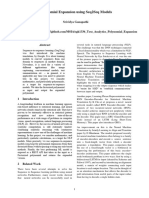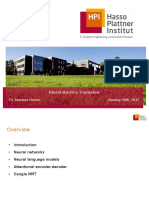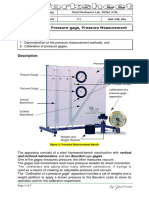0% found this document useful (0 votes)
36 views22 pagesNatural Language Processing-Section
The document discusses machine translation, which uses AI to automatically translate text between languages, exemplified by tools like Google Translate. It explains the architecture of Long Short-Term Memory (LSTM) networks, which address issues in traditional Recurrent Neural Networks, and outlines the process of preparing and training a machine translation model from English to French using LSTM. Key components include encoder and decoder techniques, data preparation, and model training with specific libraries like TensorFlow and Keras.
Uploaded by
dw9324764Copyright
© © All Rights Reserved
We take content rights seriously. If you suspect this is your content, claim it here.
Available Formats
Download as PPTX, PDF, TXT or read online on Scribd
0% found this document useful (0 votes)
36 views22 pagesNatural Language Processing-Section
The document discusses machine translation, which uses AI to automatically translate text between languages, exemplified by tools like Google Translate. It explains the architecture of Long Short-Term Memory (LSTM) networks, which address issues in traditional Recurrent Neural Networks, and outlines the process of preparing and training a machine translation model from English to French using LSTM. Key components include encoder and decoder techniques, data preparation, and model training with specific libraries like TensorFlow and Keras.
Uploaded by
dw9324764Copyright
© © All Rights Reserved
We take content rights seriously. If you suspect this is your content, claim it here.
Available Formats
Download as PPTX, PDF, TXT or read online on Scribd
/ 22


































































































